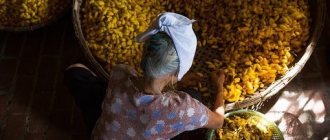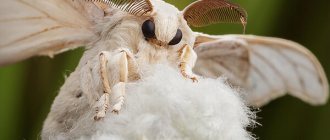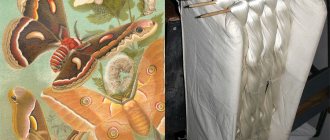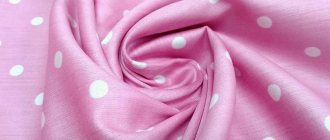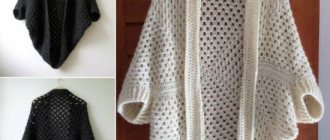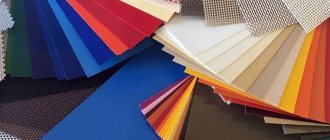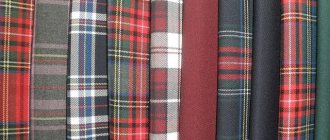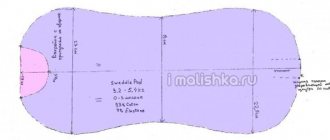Secret behind seven seals
As already mentioned in the first part, the Chinese kept the secret of silk very carefully for several thousand years. Anyone who dared to take silkworms out of China faced execution.
However, despite all the secrecy, the Chinese were destined to lose their monopoly on silk production. Sericulture came to Korea around 200 BC, when a wave of Chinese immigrants arrived. Soon after 300 AD, sericulture spread to the West and to India.
Legend has it that in 440 AD, the prince of Khotan (present-day Hetian), a kingdom on the edge of the Taklamakan Desert, won the hand of the Chinese princesses. And when she left China, she secretly took with her the eggs of the famous silkworm. They say she hid them inside her voluminous hairstyle. However, this was little consolation for silk-hungry Westerners, because Khotan also kept this secret. Why share this with Westerners and kill a good market?
Then, around 550 AD, two Nestorian monks appeared at the court of the Byzantine Emperor Justinian. They hid the silkworm eggs in hollow bamboo poles. Under their supervision, the first imported silkworms hatched from their eggs and wove their cocoons. Byzantium finally began producing silk. The Byzantine church and state created imperial workshops, monopolizing production and keeping secrets to themselves. This allowed the creation of a silk industry in the Middle East, reducing the market for conventional grades of Chinese silk. However, high-quality silk fabrics woven in China specifically for the Middle Eastern market continued to generate high profits in the West, and so trade along the Silk Road continued as before.
History of silk
Such different legends...
The secret of making silk was born in China 5000 years ago. As an ancient legend says, one day young Lei Ji, the wife of the legendary Emperor Huang Di of China, the Yellow Emperor, was sitting in the garden of the imperial palace, under the crown of a mulberry tree, drinking tea, and at that moment a silkworm cocoon fell into her cup from the tree. The Empress and her maids were extremely surprised to see how the cocoon began to unfold in hot water, releasing the finest thread. Having become interested, the girl began to watch how the cocoon unfolded. Lei Ji was so amazed by the beauty and strength of the thread that she collected many cocoons from the mulberry tree and wove clothes from them for the emperor.
As an ancient Chinese legend tells, China owes the art of silk making to the wife of the Yellow Emperor, the mythical founder of the Chinese state, because it was she who taught her people to breed caterpillars and weave fabric. That the art of making silk was discovered in China is perhaps not an accident, since the silkworm, which produces the best fiber, feeds on the leaves of the white mulberry, which is native to China. A closely related species, the wild silkworm, lives in East Asia: in the northern regions of China and the southern regions of the Primorsky Territory of Russia.
According to ancient Chinese legends, silk (ssu - silk in Chinese, sheshi - in Hebrew) was accidentally discovered by the first wife of the Chinese Emperor Huang Ti (reigned 2698 - 2598 BC), after which the emperor's wife was elevated to the rank of Goddess of Silk . Archaeological finds suggest that silk was actually known in some regions of China about a thousand years before Huang Ti.
In fact, the oldest silkworm cocoon was found in a Neolithic settlement in the northern province of Shanxi (c. 2200-1700 BC), and the first fragments of silk fabric were found in one of the tombs of southern China, from the time of the Warring States (475-221 BC). . BC.)
The art of silk making is an integral part of ancient Chinese civilization. Silk prices have been high throughout the centuries. Silk was more expensive than gold. For a bundle of silk fabric they paid in double measure of gold coins, taking into account the small weight of the goods. Hostility and rivalry often arose over silk. It is known that the Romans, seeing the silk banners of the Parthians fluttering in the wind, experienced not only surprise and delight, but also burning envy, which turned into war. In China, the rulers had a monopoly on the production of silk, as well as on the production of porcelain, paper, and gunpowder.
Caterpillar – supplier of the imperial court
Traditionally, silk is obtained from the domesticated silkworm. Modern science has explained that silk thread is a product of the secretion of the silk glands of the silkworm caterpillar. An adult Bombyx mori butterfly lives only 10–12 days and during this time lays 500–700 eggs. After 8–10 days, caterpillars emerge from the eggs, which are called silkworms.
A caterpillar emerges from the egg, grows quickly and molts four times. After the caterpillar has gone through four moults, its body turns slightly yellow. The caterpillars develop within 26 - 32 days. The duration of development depends on the temperature and humidity of the air, the quantity and quality of food, etc. The pupating caterpillar weaves a cocoon, the shell of which consists of a continuous silk thread ranging from 300-900 meters in length to 1,500 m in the largest cocoons. In the cocoon, the caterpillar turns into a pupa.
The color of the cocoon can be different: pinkish, greenish, yellow, etc. But for industrial needs, currently only silkworm breeds with white cocoons are bred. The emergence of butterflies from cocoons usually occurs 15-18 days after pupation. But the silkworm is not allowed to survive to this stage - the cocoons are kept for 2-2.5 hours at a temperature of about 100 °C, which kills the caterpillar and simplifies the unwinding of the cocoon. Thread properties are measured in denier. Denier is the mass in grams of a thread 9 km long. A silkworm thread weighs 1 denier, a human hair weighs 40–50 denier. The tensile strength of a thread is determined by the tensile strength of the thread and is expressed in grams/denier. Thus, the strength of the silk thread is 3.7. Compare: nylon is only 5.3, and steel is not much stronger than silk thread - 3.5.
All stages of development and growth of the caterpillar pass within 30 days, after which they begin to weave a cocoon, releasing the contents of their silk glands, which in the air turns into mulberry - a double thin thread, which includes fibrion coated with sericin. The caterpillar weaves a thread from 500 to 2000 m long over three days. The high elasticity of silk threads allows them to be twisted and intertwined in various ways. The length of the silk thread reaches 800-1000 m. The thread has a triangular cross-section and, like a prism, reflects light, which causes a beautiful iridescence and shine.
About 5,000 years ago, Chinese weavers made the first silk fabric. The ancients loved to repeat that “from small things great things are built.” A small, inconspicuous butterfly with the sonorous name Theophylla mandarina gave silk to humanity, and although not all experts recognize its authorship, the truth can no longer be found in the depths of time.
Silk is an extraordinary raw material, neither of plant nor animal origin. The silk thread is created by a caterpillar, or rather a butterfly, which lays grains from which silkworm caterpillars hatch. This is a real factory, so flawlessly executing the genetic program that modern science can only watch in admiration what is happening. The performance always starts at the same time - in warm weather at dawn and lasts until 10 am. Caterpillars hatch from the grem. From now on, they need a lot of fresh mulberry tree leaves. Caterpillars live for 3-4 weeks, during which time they should become 30 times longer and 10,000 times heavier. And here is the culmination of all the action! The insect begins to wrap itself in a cocoon and build armor against enemies. When the thread leaves the caterpillar's body, it is in a gelatinous state, then it hardens and the Great Winding begins. The silkworm shakes its head at a speed of two times per second, without stopping, and so on up to four thousand turns!
The length of the thread in the cocoon is about a kilometer! The thread does not break - this is the genetic program. The strength of a silk thread is the same as that of a steel wire of equal diameter, but it is many times more elastic. Until recently, silk threads were successfully used in surgery.
The mystery spreads...
The earliest descriptions of silk production date back to the Yin Dynasty. Even then, there were machines for unwinding silk threads, equipped with a foot drive and a drum for winding threads. The productivity of such machines reached 1.5 kg of silk yarn per day. Weaving looms were used to wind threads onto bamboo spools. The first primitive looms in silk production have been known since the end of the first millennium BC. e. By the end of the Middle Ages, the Chinese were already using sophisticated machines to produce colorful patterned silks.
Long before the discovery of the technology of unwinding a cocoon in order to obtain the finest thread, silkworm cocoons were used in China to make strings for musical instruments and fishing lines. At that time, silk fiber was simply squeezed out, obtaining a homogeneous mass, from which, in turn, a fairly thin thread was simply pulled out. Already 3500 years ago in China there were musical instruments with silk strings.
The quality of the cocoon thread depends on the type of insect and the leaves of the plant on which it feeds. This also explains the variety of silk fabrics. The silkworm is the most common reproductive insect on earth. It produces fiber for taffeta, satin, satin, organza, and chiffon. Fabrics with a “coarser” texture (tassar, eri, maga) are made from the fibers of caterpillars living in the territory of modern India, fed on the leaves of oak, castor bean and polyantas trees.
The silkworm is not the only producer of silk threads on Earth. In nature, there are about 200 species of butterflies, whose caterpillars pupate in cocoons. Humans use about 80 genera of wild silkworms to produce silk, the main of which is the Chinese silkworm. However, it is worth noting that the properties of some silkworms are superior to the silkworm in a number of indicators.
It is impossible not to mention spiders, since the properties of the web are very close to silk thread, the main difference being the low content of the adhesive substance sericin. At the same time, the web is stronger and more elastic than silk thread.
The production of silk fabrics from mulberry, created from the threads of a silkworm caterpillar when curling a cocoon, originated in China approximately 4,500 years ago. But we can talk about the industrial scale of silk production starting from about 500–300 BC. e. It was at that time that silk became most widespread. Silk was used to collect taxes and was used as a means of payment. Silk was also considered a very expensive gift.
The best silk, of course, was used to make the emperors' robes. At the same time, the clothes that were worn for the ritual of ancestor worship were certainly created with one’s own hands, this even applied to members of the imperial family. Silk, which was given as a wedding gift to the bride, or silk fabric in which the body of the deceased was wrapped, was also not bought, but was made independently by the closest relatives. The industrial scale of silk production can be said to date from about 500–300 BC. e. It was at that time that silk became most widespread. Silk was used to collect taxes and was used as a means of payment. Silk was also considered a very expensive gift. The best silk, of course, was used to make the emperors' robes. At the same time, the clothes that were worn for the ritual of ancestor worship were certainly created with one’s own hands, this even applied to members of the imperial family. Silk, which was given as a wedding gift to the bride, or silk fabric in which the body of the deceased was wrapped, was also not bought, but was made independently by the closest relatives.
China has kept the secret of silk production for 20 centuries. The export of silkworms outside the state and the disclosure of silk production technology were punishable by death. The fabric itself was exported in large quantities to other states. Particularly convenient for transportation, lightweight silk became a favorite product of Chinese merchants. The fabric was sold along the entire route of the merchants, despite its high cost. Silk was equally highly valued in India and Parthia, as well as in Rome and Alexandria. To deliver valuable goods in the 2nd century BC. e. Chinese merchants paved the Great Silk Road. Along it, silk reached Greece and Rome through Central Asia, and by sea, through India, to the countries of the Near and Middle East.
The Great Silk Road
In the 2nd century BC. The routes for the movement of trade caravans from the interior of China and India through Central and Western Asia to the ports of the Black and Mediterranean Seas began to take shape. These roads were called the Great Silk Road by all the peoples who inhabited vast spaces. It existed until the 16th century, when shipping replaced the caravan method of delivering goods. All along the Silk Road, their own national schools of silk craft arose - Indian, Byzantine, Persian, Turkish, and European.
However, no distribution bans could stop the thirst for profit. And in the 3rd century BC. e. silk manufacturing technology was exported to India. In the 2nd century BC. e. Chinese colonists had already used the technology in Korea, from where in the 3rd century AD. e. she came to Japan. Thus, the closest neighbors quickly learned the secret that China so zealously kept.
In Europe, until the 6th century, silk was known only as an overseas product, paying fabulous sums for it. However, during the reign of Emperor Justinian, in the middle of the 6th century, due to the war with Persia, the route along which silk was delivered to Byzantium was blocked. And the Byzantine court, known for its passion for luxury, was faced with the problem of purchasing silk.
Legend has it that Europe was “saved” by two monks: they took out grena (mulberry caterpillar eggs) in hollow staves. In 533, silkworm eggs were delivered to Byzantium, and the caterpillars hatched from them were released onto mulberry trees. According to another legend, silk came to India thanks to the cunning of an Indian king, who wooed a Chinese princess and demanded mulberry seeds and silkworm larvae as a dowry. Unable to refuse the groom, the princess hid the seeds and larvae in her hair and took them out of China.
For many centuries, no one outside China was able to master the technology of silk production, since revealing the secret was punishable by death. Enormous efforts were spent to find out this secret. There is a well-known legend about how silk production arose in Khotan. The local ruler could not get hold of the source data and method of producing the coveted material. Then, on the advice of his minister Yuchi Mu, he decided to cheat and wooed the Chinese princess. When the proposal was accepted, the envoy of the Khotan ruler whispered to the princess that in her husband’s homeland there was a lot of excellent jade, but there was no exquisite silk, and if she wanted to wear the same beautiful clothes as before the wedding, she should bring silkworm eggs and seeds with her mulberry tree. The girl brought everything she needed to Khotan, hiding the eggs in her intricate hairstyle and the seeds among bags of herbs and potions. The enterprising princess thought much bigger than her fiancé and took with her, under the guise of domestic servants, specialists in silkworm breeding, mulberry tree breeding and weaving.
According to another legend, in 550, the Byzantine emperor Justinian I persuaded two Persian monks to bring him precious silkworm eggs from China. The monks hid them in a hollow bamboo stick. The true story remains unknown. One way or another, a carefully guarded secret for centuries was revealed.
Thus, one of the greatest secrets of humanity, preserved for thousands of years, ceased to exist. Byzantium quickly developed its own production of silk fabric. And in the 8th century, silk production was already being done in Europe, initially in Spain, and then in Italy and France. Italy and France are particularly successful in this industry. By the 17th century, sericulture had spread throughout almost all of Asia, the Mediterranean, as well as some countries in Africa and America.
Silk in Europe
In the Middle Ages, silk became one of the main industries in Venice (XIII century), Genoa and Florence (XIV century), and Milan (XV century). By the 18th century, silk making had spread throughout Western Europe.
The tradition of sericulture in China originated in the Neolithic (V-III millennium BC). At the turn of the new era, many varieties of silk were already widespread in China: dense, crepe-like, thin gauze, complex weaving, silk with a variety of embroidered patterns... Before dyeing, the silk was washed, boiled and bleached. Mineral and vegetable dyes were used for coloring. To create more complex shades, the fabrics were dyed multiple times.
Only finished fabrics were supplied to Europe. According to the Chinese, silk shines like gold and flows like water. In the 18th century brown colors of various shades were in fashion, which were called, for example, “flea in milk fever”, the color of “young flea”, “old flea”, “back of a flea”, “abdomen of a flea”. In the middle of the 19th century. Silk is in fashion again, but in white, soft pink and blue colors - women in dresses made of this silk resembled “fluttering clouds”.
The development of Russian sericulture begins during the reign of Tsar Mikhail Fedorovich (1596–1645), when the first mulberry plantations were established. In 1741, the first silk factory in Russia was created. At the beginning of the 19th century, there were already 230 factories producing silk fabrics in Russia. However, silk in Russia was almost always made from imported raw materials, since the production of its own cocoon raw materials was not sufficiently developed. By the end of the 20th century, only about 10 thousand tons of raw cocoons were mined in Russia. For comparison: in China at the same time, 150 thousand tons were mined per year, and the production of cocoons throughout the world at that time was about 450 thousand tons per year.
Silk fabrics
Brocade and velvet. Venetian merchants, having an excellent fleet, uninterruptedly supplied the entire European nobility with eastern cracks. In Russia, brocade was in particular demand until the beginning of the 18th century. The word “brocade” comes from Persian which means “cut”, “piece”. This is silk fabric with a metal weft (most often not from gold or silver, but from tinsel, i.e. just metal thread)
By the 18th century, the primacy in brocade production passed to Italian and French manufactories. In Russia, brocade has always been a symbol of splendor and power. Contrary to European fashion, Russian ladies wore brocade dresses to official receptions even in the 19th century. Among the Russian factories that produced velvet and brocade, the Alekseev Brothers factory was famous. One of the brothers is Konstantin, a world-famous theater reformer. It was he who took the pseudonym Stanislavsky. In Russia, only silk-based velvet was valued, and paper-based velvet was considered not prestigious. Velvets were plain, printed and embossed.
The main thing in silk velvet is the shine and iridescence of the shades, so the pile of good velvet was woven very tightly and cut low. In old Rus', velvet was considered not only a sign of wealth, but also of nobility; it was called “Venetian”, “Turkish”, etc., depending on where it was brought from. In the 19th century, all known varieties of velvet were already produced in Russia: velor, ivy, pan-velvet, plisse, Utrecht velvet, trep and many others. In the 1940s, pan velvet based on chiffon or georgette was fashionable.
Lyon grodetours. Throughout the 18th century, Italian silks remained very popular, but they were gradually being replaced by French gros (one of the meanings of the word gros is basic, main). The presence of this word in the name of silk is a sign of the highest quality. It was in France at the Great Lyon Manufactory that a new style of silk ornamentation was created. Moire and patterned grodetours, damask, satins woven with colored silk threads, gold and silver, patterned, single-color and multi-color velvet are woven there. By order of Catherine II, a certain French weaver and draftsman Philippe de Lassalle wove a series of decorative fabrics to decorate the walls of the palace premises in Peterhof and Tsarskoe Selo.
Fru - Fru. This is the name of a frill made of silk fabric. which in the 19th century was worn specifically to make the dress rustle loudly. The rustle of silk has been valued at all times along with its shine. When making silk fabrics, there are various types of thread twisting, as well as weaving methods. All this determines the names of fabrics. Crepes became especially famous. There were several varieties: English, georgette, satin, Chinese (crepe de Chine), Marroquin... No less famous satins: blond, Warsaw, pompadour, Portuguese.
Among fine silks, gauze is considered the most exquisite. There are about 10 types of this fabric, followed by muslin and chiffon. Very famous silk fabrics have a matte and shiny side - fail.
Chesucha stands apart. This silk fabric is made from raw threads and ranges from light golden to brown in color. The production of synthetic fibers, which began in the late 1930s, could not shake the Great Empire of natural silk. The high aesthetic and environmental properties of silk fabrics make them eternally fashionable.
Silk is the yarn of the mulberry plant, mulberry plant or silkworm (i.e. caterpillar), which is obtained through various processing. Fibrous raw silk is silk cocoons broken into fibers that have not undergone processing. These fibers can then be spun into yarn by hand or by machine. Fibrous silk produces “harsh”, rough-looking products, but light and pleasant to the touch.
Sewing silk is machine-spun silk intended for further weaving. The most common and well-known type of silk, widely used in the manufacture of accessories by designers around the world.
Handmade cocoon silk is silk yarn obtained by drawing silk fiber from 2 or several cocoons, which is laid in “silk tracks” and does not twist. The production of such yarn is entirely handmade, since untwisted silk is especially delicate and requires a delicate weaving process, and therefore cannot be processed on mechanical machines.
Wild silk - this silk is not unwound from the cocoon of the silkworm, but is combed from the cocoon of the oak (or wild) silkworm, so it looks more like flax or wool. It has excellent hygroscopicity - the ability to absorb moisture, strength and sometimes has dark inclusions, which gives it the charm of ethnic antiquity. Therefore, medium-density wild silk is very popular among those who are interested in martial arts. Wild silk is good in hot weather and makes wonderful safari shirts and shorts. Since this type of fabric is rarely dyed and bleached, it is very suitable for clothing for expectant mothers and babies, as well as for people prone to allergies and with the problem of excessive sweating. There is a “completely wild”, coarse silk of the “matting” type with a density of 200g/m2 and a width longer than 2m for the interior, but more on that later. Very good for painting in ethnic style (except for the cold batik technique). The edges of wild silk (if it is a poncho or stole) do not need to be hemmed, but simply “tugged”. It turns out to be a very nice fringe.
Imperial silk - there is also 1 type of silk fabric, which in ancient China only the emperor was allowed to wear. This silk was laid out on the banks of a river in the province of Su-Jaw, smeared with silt and algae from the bottom of the same river and kept under the scorching sun for exactly 14 days (half the lunar cycle). Seaweed-dyed silk has two sides - a black front and a brown back (velvety and pleasant to the body) and has unique properties: it soothes skin suffering from psoriasis.
Present time...
Currently in Europe, silk production is developed mainly in France, England, Switzerland, Italy; In addition, artificial silk is produced; it owes its appearance to the French chemist Chardonnay, who prepared it from collodion dissolved in ether with alcohol.
The world's largest silk producer is China (about 50% of total world production). India produces about 15% of the world's silk, followed by Uzbekistan (about 3%) and Brazil (about 2.5%). Iran, Thailand and Vietnam are also significant producers.
Silk has long been valued for its beneficial and healing properties. Studies have proven that people who regularly wear silk products suffer less from diseases such as arthritis and rheumatism, cardiovascular and skin diseases, colds and flu. In addition, natural silk has antibacterial properties. Silk is the only natural material that maintains an ideal microclimate for humans depending on temperature. Many people also prefer silk products because silk does not harbor saprophytes or dust mites, the existence of which until recently we did not even suspect due to their insignificant size. Silk textiles are 100% natural and have unique living energy.
The fabric made from such environmentally friendly threads is smooth and soft. In direct contact with the human body, the friction coefficient reaches a minimum and creates a pleasant sensation. At normal temperatures, such clothing to a certain extent retains the necessary heat, moisture and brings coolness, as it has the properties of moisture protection and quick drying.
Silk fabric has the ability to reflect ultraviolet rays. According to research by psychologists, silk products have a calming effect on the nervous system, and silk bed and underwear enhance sensuality. In addition, all types of silk carry very strong positive energy.
In 2003, scientists from the Beijing Institute for Research in Traditional Medicine conducted a series of experiments on the effect of silk on the human body. It turns out that human contact with silk is not only pleasant, but also useful. Men, women and children under the age of 13 who participated in the experiments experienced an increase in oxytocin, a hormone that relieves depression and also lowers blood pressure, that is, reduces the risk of heart disease.
Silk effectively increases hemoglobin levels in the body. And since hemoglobin is a blood pigment that carries oxygen from the respiratory organs to the tissues, increasing its level strengthens the entire body, strengthens the immune system and speeds up recovery from many diseases. Silk products are used to prevent diseases such as arthritis and asthma and, in addition, natural silk has antibacterial properties.
Chinese doctors recommend to their patients the use of silk-filled bedding as a good way to get an energy boost. Scientists have also established a significant positive effect of natural silk on the child’s body, since it protects against germs and bacteria that cause various skin irritations.
Most importantly, silk has the ability to influence the brain of children, enhancing at an early age such qualities as the correct perception of sounds and colors, which has a positive effect on the child’s intelligence.
Under a silk blanket, a child falls asleep well; silk completely repels any bacteria or any other negative effect on the human body, for which magical healing powers have been attributed to it since ancient times in China and Japan.
Go to the store Next section
Silk Road
Silk very early became a precious commodity, in great demand in other countries. It is believed that the silk trade began even before the official opening of the Silk Road. It owes its name to the profitable trade in this material that was carried on throughout its entire length. It was this path that allowed people living in places far from silk cultivation to acquire and use it.
For example, it was found in Egypt, in the village of Deir el-Medina. Female mummies were wrapped in it. The find dates back to 1070 BC. This is probably the earliest evidence of silk trade.
In the 2nd century BC, the Chinese Emperor Han Wu Di sent envoys as far west as Persia and Mesopotamia, and one of the most precious gifts they brought with them was silk. The Han embassy reached Baghdad in 97 AD, and it was there that important finds of Han silks were made. One of the most striking discoveries of Tang Dynasty silks along the Silk Road was made in 1907 by Aurel Stein.
Unique butterfly
The territory of many countries is home to a large number of species of wild silkworms. Why did China invent silk and begin to dominate its production? It turns out that this mystery is connected with one unique species of butterfly: a blind and flightless silkworm called Bombyx mori. Her life is short. The butterfly lives only three to six days, laying approximately 500 or more eggs during this time, after which it dies. It does not even have a full-fledged mouthparts, so it exists at the expense of the reserves it accumulated at the caterpillar stage. 100 silkworm eggs weigh only 1 gram. From 10 grams of eggs, about 10,000 caterpillars are born, which eat a whole ton of mulberry leaves and ultimately produce 5.5 kilograms of raw silk.
The wild ancestor of the domesticated silkworm species is considered to be Bombyx mandarina Moore, which lives only in China and lives on a white mulberry tree. It is this species that produces smoother, thinner and rounder thread than other silkworms. Over the thousands of years during which the Chinese practiced sericulture, the silkworm Bombyx mori evolved into a specialized silk producer. He still is today. During the process of domestication, it lost the ability to fly and live in the wild.
Ancient Rome
No one knows when exactly the ancient Romans first developed silk.
It is known for certain that in the 4th century BC. In Greek and Roman texts, references to Seres, the Kingdom of Silk, began to appear for the first time.
History also knows that back in 53 BC, at the Battle of Carrhae, Roman soldiers were so shocked by the sight of bright silk banners and Parthian troops that they fled in panic. Which indicates that they were probably not familiar with this material.
As a precious commodity, silk imported along the Silk Road eventually became the calling card of the wealthy Romans. According to ancient records, by the 3rd century AD, the Roman emperor Heliogabalus, who reigned from 218-222, wore nothing but silk.
By 380 AD, when the Roman Empire was already divided into Western Rome and Eastern Rome, the Roman soldier and historian Marcellinus Ammianus reported: “The use of silk, which was once limited to the nobility, is now available to all classes without distinction, even the lowest.”
In 408, when the Goth Alaric besieged Rome, his stated price for saving the city included 5,000 pounds of gold, 3,000 pounds of pepper, 30,000 pounds of silver, and 4,000 silk tunics.
Silkworm and eggs laid by a butterfly.
0
It all starts with tiny eggs, so small that even the mass of 2,000 eggs does not exceed 1 gram. They hatch into caterpillars no larger than the head of a pin. Over the next 3 days they will increase their weight 10,000 times. And they feed on the leaves of the white chickweed
0
To produce the finest silk, they must eat nothing else. It takes about 2,000 cocoons to make 1 silk dress, which means that the caterpillars need to eat more than 70 kg of leaves - almost 2 mulberry trees.
0
The cocoons must be collected before the butterflies appear. If you leave them too long, the butterfly will gnaw through the cocoon and damage the silk. The cocoons are immersed in boiling water to kill the caterpillars and dissolve the protective layer.
Silk in our time
The industrial revolution that took place in the leading countries of the world in the 18th-19th centuries significantly influenced silk production in general. Thanks to improvements in technology, the price of cotton textiles has dropped and they have become much more affordable. This led to the fact that expensive silk lost its dominant position. However, new inventions, such as the jacquard loom created for silk embroidery, also contributed to the development of silk production. At the same time, several epizootics (mass epidemics) of the silkworm moth led to the collapse of silk production in Europe. France suffered especially, where the silk industry was never able to recover.
In the 20th century, China and Japan once again became the world's main silk producers, producing more than 50% of the world's output annually. In the late 1970s, China, the country that first developed sericulture thousands of years ago, dramatically increased silk production and is now back at the top of the market. Despite the emergence of nylon and other synthetic fibers replacing natural silk in some areas, global production of natural silk has doubled in the last 30 years!
Production technology
Silkworm cocoons are used to make natural silk threads. This species of butterfly is related to the common house moth. Obviously, silkworms originated from wild silk moths, which chose mulberry trees as a place of residence. Many insects, such as spiders, have the ability to produce silk fibers. However, such silk is not used in the textile industry.
silkworm
Data from archaeological excavations suggest that the deliberate breeding of silkworms began in China 4000-5000 years ago. As the wild moth became domesticated, it lost the ability to fly; in some individuals, the organs of vision and oral apparatus were almost undeveloped.
Female silkworms lay several hundred tiny eggs and die after a few days. The eggs are carefully checked and undergo several tests for various infections. Healthy eggs, which will then be used for further production, are sent to an incubator. After about a week, larvae emerge from the eggs. They are monitored very carefully; the room where the silkworms are kept is maintained at a constant temperature and humidity, and no loud noises are allowed. At this stage of development, silkworms eat constantly to gain strength before turning into a butterfly. Their diet includes mulberry leaves, citrus peels and lettuce. After about a month, the larvae begin to prepare for the last stage of their growth and begin to spin a cocoon.
With the help of special glands, caterpillars produce a special thick mass that hardens upon contact with air. This mass consists of two main substances:
- fibroin is a protein that many insects can produce.
- Sericin is an adhesive substance that holds the threads together.
Despite the fact that silk threads are much thinner than human hair, they are very durable. After all, while the larva is in the cocoon, it must be protected from predators and moisture. It takes no more than 4 days to create a cocoon for a seven-centimeter larva. After this, the cocoons are sorted depending on color and quality. White cocoons are most suitable for textile production. In order to obtain more raw materials of the desired color, Chinese breeders have been crossing certain individuals for centuries. After about a week and a half, shortly before the larvae can leave the cocoon, it is time to collect the silk. The cocoons are placed in hot water, this kills the caterpillars and destroys some of the sticky sericin. If you leave the cocoons too long, the caterpillars will turn into butterflies and break the silk threads.
Now the cocoons can be unwound. One silkworm produces from 600 to 1000 meters of silk thread. In order to obtain a thread suitable for textile production, it is necessary to connect 5-7 threads produced by caterpillars. Before weaving the fabric, the threads are twisted again so that they become even and smooth. They are then thoroughly washed and cleaned. Silk skeins can now be dyed and sent to weaving looms.
Today, silk production in China is a high-tech process, but thousands of years ago all manipulations with silk threads were done by hand.
Silk in Rus'
It is believed that sericulture came to Russia only during the reign of the first Russian Tsar from the Romanov dynasty, Mikhail Fedorovich. For the first time, mulberry plantations were developed near Moscow, in the village of Izmailovka, and then in regions of Russia more favorable for sericulture - in Astrakhan and Akhtuba. And by decree of Peter I, similar farms appeared in Kyiv, Constantinograd and on the Terek. With the annexation At the end of the 18th century, when Crimea joined Russia, sericulture spread to the Crimean lands. However, the craft did not become widespread due to the generally unfavorable climate and, as a result, frequent diseases of silkworms.
But not everything is so simple with silk in Rus'.
Some archaeological finds of this material made on the territory of our state turned out to be older than the Silk Road itself. This will be my next article. History of silk - part l Choose a silk scarf Share:
Silkworm caterpillar.
0
The caterpillar makes quick, uniform movements with its head and lays out the thread in a figure-of-eight shape.
0
She can repeat these movements up to 230,000 times, and the length of the silk reaches up to 1,000 meters. After 2-3 days, the cocoon is ready, and a miracle begins to happen in the silk house. The caterpillar stays in the cocoon for about 3 weeks and there it turns into a butterfly.
Interesting facts about silk
- In the Roman Empire, silk was so expensive that it was worth its weight in gold and was often used as a means of payment in trade transactions. Only very wealthy people were allowed to wear silk outfits.
- In the 15th century in France, lovers' beds were covered with silk fabrics - in those days they believed that silk increased love power.
The silkworm is the only fully domesticated insect, practically not found in nature in the wild, and the most common reproductive insect on Earth.
Chemical formula of silk: C15H23O6N5
Caring for silk clothes
Silk is a material that, if properly cared for, can last up to 20 years. In the washing machine, clothes made of natural silk should be washed exclusively in a gentle cycle. In this case, it is optimal to use detergents intended for silk. Temperature – no higher than 30°C, without soaking or using bleaches, and without spinning at high speeds.
Silk also needs to be washed by hand correctly. Namely, do not rub or squeeze too hard.
Silk items should be rinsed in water at a temperature of 20-25°C. You can add a little vinegar to the water (5 tablespoons of 9% vinegar per 10 liters of water) - this will help eliminate the harmful effects of alkali and refresh the color of the product.
Do not dry silk items in the sun, radiator, or near heating appliances. It is necessary to hang the silk item to dry in the shade, straightened out. Silk items should be ironed while wet and only from the inside out. You need to use a moderately hot iron, and do not wet the fabric during ironing. It is advisable to keep the iron pressed for no more than 5 seconds to prevent damage to the fabric.
Traces of sweat left on clothes made of natural silk can be removed with alcohol.
Silk as Chinese currency
It is believed that the first silk products had the right to be worn exclusively by noble persons - the emperor and his family, as well as his highest dignitaries. There was a tradition of wearing white silk inside the palace and yellow silk outside. However, gradually silk began to be used more widely, and eventually even the simplest people could afford silk items.
In addition to the fact that silk was used in the manufacture of clothing and jewelry, the Chinese quickly began to use it in industry. In Western civilization this happened much later, in our days. Silk production very quickly became one of the leading sectors of the Chinese economy. It was used in various spheres of life - in the manufacture of bowstrings, fishing lines, musical instruments, plain paper and all types of securities.
During the Han Dynasty, silk turned from an industrial material into a kind of currency. Now farmers began to pay taxes not only on grain, but also on silk. It began to be used as payment for civil servants and as a reward for outstanding services. Very quickly it became the currency used in trade with the whole world. This role for silk continued into Tang times. The value of anything was estimated by the length of the silk sheet, just as in other countries the weight of gold or silver was used as a unit of measurement of value. The word "silk" has penetrated so deeply into the Chinese language that 230 of the 5,000 most common characters in the Mandarin alphabet contain the sign for silk as their "key".
Silk remains an important commodity to this day, and today there are a number of financial instruments and various silk-based securities, including binary options and futures.
And designer silk products, along with works of art, are coveted collectibles. History of silk - part ll Choose a silk scarf
